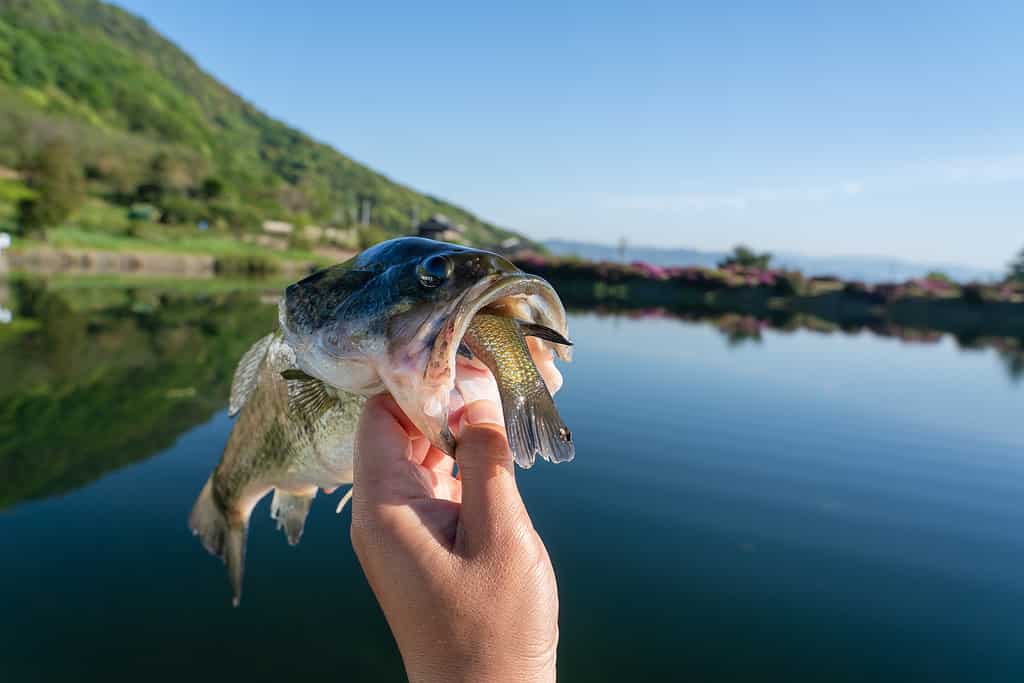There are 196 fish species swimming in Illinois waters. These species represent 77 genera and 28 families. However, out of those nearly 200 species, only one is honored as the state fish. The official Illinois state fish is the bluegill.

The Illinois State Fish
In 1986, the schoolchildren of Illinois were given an opportunity to vote on the state fish. They chose the bluegill as the official fish to represent the state.
The choice may have brought a smirk to the faces of many experienced anglers, but maybe those anglers forgot the important role that the humble bluegill played in their lives. Most fishermen and fisherwomen in Illinois will tell you that the first fish they ever caught was a bluegill. They may have moved on to pursue bigger gamefish as they grew up, but the bluegill was where they got their start. From this perspective, could there be a more worthy fish to represent the state? The next generation of anglers to cast a line into Illinois waters will most likely reel in bluegill as their first fish.

The bluegill is the star of the show on most childhood fishing trips.
©iStock.com/woogies1
Bluegill (Lepomis macrochirus)
The bluegill is also known as bream or bluegill sunfish. It is a true sunfish in the order Perciformes, family Centrarchidae (the sunfish family). Other well-known fish in the Centrarchidae family include the largemouth bass, smallmouth bass, rock bass, pumpkinseed, black crappie, and white crappie.
Bluegills are native to North America, east of the Rocky Mountains. They have been stocked throughout the continental United States and can also be found in southern Canada and northern Mexico.
The bluegill is a slab-sided (tall and flat) fish. It typically features a dark olive-green color along the back with lighter sides. The fish has deep blue hues on its face and gill cover (hence the name, bluegill), a black earflap (opercular flap), five to nine vertical dark bands on its side, and a bright yellow/orange belly.
The color varies with the water quality, geographic location, age, and sex of the fish. Adult males are more brightly colored than females. During the spawn, males take on even more vibrant colors. The fish has a small mouth and a spiny dorsal fin over the back and soft toward the tail. An average mature bluegill measures six to eight inches long and weighs one pound or less.

Bluegills feature vivid colors, from the black earflap to the orange belly.
©Stacey Ann Alberts/Shutterstock.com
Prey and Predators
Bluegills have a voracious appetite and are predatory assassins. Their diet mainly consists of insects, but they will also eat zooplankton, worms, snails, freshwater shrimp, crayfish, tadpoles, smaller fish, and more. If a bluegill can fit the animal in its mouth, it is a potential prey target.
The bluegill is also an important prey species for larger predators. Bass, catfish, muskie, pike, walleye, and many other larger fish prey on bluegill. Larger bluegills will also cannibalize smaller bluegills.
Birds such as hawks, herons, kingfishers, and others often feed on bluegill. Water snakes are known to predate bluegill. Mammals such as otters and raccoons also enjoy dining on bluegill.

Bass often prey on bluegill, such as this one that was apparently caught in the middle of its meal.
©iStock.com/SAND555
Bluegill Fishing in Illinois
Bluegills often conjure up the nostalgia of childhood worm-and-bobber fishing trips. Due to their aggressive predatory nature and wide-ranging diet, these fish are among the easiest to catch of any freshwater fish. Young children can hook them with a small child-sized fishing rod. Bluegill can even be caught on cane poles, the simplest of all fishing apparatuses.
However, bluegill are more than just the fish of childhood memories. Ounce-for-ounce, bluegills are among the hardest-fighting fish around. Hooking a large bluegill on light tackle is a thrill, even for veteran anglers.

Bluegills fight hard after they’ve been hooked.
©T. Antos/Shutterstock.com
Bluegill can be found in all of Illinois’ 102 counties. According to creel surveys by the Illinois Division of Fisheries, anglers in the Prairie State catch more bluegills than any other fish each year.
Bluegills inhabit water ranging from rivers and streams to large lakes and small ponds. Joe Ferencak, impoundment program manager of the Division of Fisheries in Illinois, recommends these waters for some of the best bluegill fishing in the state.
- Hennepin Canal
- La Salle Lake
- Upper Mississippi River
- Argyle Lake
- Mazonia Lakes
- Dawson Lake
- Baldwin Lake
- Crab Orchard Lake
- Horseshoe Lake
- Vernor Lake
- Cedar Lake
- Ramsey Lake
- East Fork Lake
- Devils Kitchen Lake
Record Bluegill
The Illinois state record bluegill weighed 3 pounds, 8 ounces. Darren May caught that monster bluegill in a private pond on May 10, 1987
The world record bluegill weighed a whopping 4 pounds 12 ounces. That massive fish was caught in Alabama on April 9, 1950.
Bluegill as Table Fare
Bluegills are panfish, a slang term used for fish that fit perfectly in a frying pan. Other panfish include crappie, pumpkinseed, rock bass, warmouth, white bass, white perch, and yellow perch. Since it is an informal term, there is no scientific definition for what constitutes a panfish.
Many consider bluegill to be a top-tier freshwater fish for table fare. The fillets are firm with a mild, sweet flavor. Bluegill fillets do not have a strong “fishy” flavor that many people find off-putting.
Bluegill may not appeal much to those who prefer white tablecloths and wine, but it is tough to beat for a casual fish fry with family and friends. Along with being a tasty fish, the bluegill is also one of the easiest fish to clean and prepare. The video below demonstrates how to quickly and easily fillet a bluegill.
The fillets are small since most bluegills weigh a pound or less, so you will need a lot of fish to feed a family. However, their large numbers in many bodies of water combined with their highly aggressive nature means you can catch a “mess” of bluegills fairly easily.
Removing bluegills from the water is often healthy for the ecosystem. Bluegills reproduce in prolific numbers. They can overrun a body of water, especially if it’s a small lake or pond. Removing some bluegills will help other fish thrive due to less competition for food and habitat.
A Bit of Illinois/Bluegill Trivia
While the bluegill was named the state fish of Illinois in 1986, the historical connection between the state and the fish dates back even further.
In 1960, Chicago mayor Richard Daley gifted bluegills to Akihito, Crown Prince of Japan. While the prince was in Chicago, he was very interested in visiting the Shedd Aquarium. Daley was an avid fisherman himself, so he gave the prince 18 bluegills.

This picture of Crown Prince Akihito (left) was taken in the 1960s.
©Australian Paralympic Committee / CC BY-SA 3.0 – License
Akihito was and still is an ichthyologist (one who studies fish) and has even published articles in scientific journals. His main focus is the study of goby fish.
The prince readily accepted the gift from Mayor Daley, hoping bluegill could be farmed in Japan to provide a new culinary treat for the Japanese people.
The prince donated the bluegills to Japanese fishery research agencies. However, the fish escaped from their confines and proliferated in Japanese waters. The bluegill is now considered an invasive species in Japan, especially in Lake Biwa in Shiga Prefecture. Akihito later remarked, “My heart aches to see it has turned out like this.”
It was a noble and thoughtful gift from the mayor of Illinois’ largest city and a forward-thinking plan from the Crown Prince. But apparently, the tenacious and prolific bluegill had other ideas.
The photo featured at the top of this post is © iStock.com/Dewitt
Thank you for reading! Have some feedback for us? Contact the AZ Animals editorial team.






